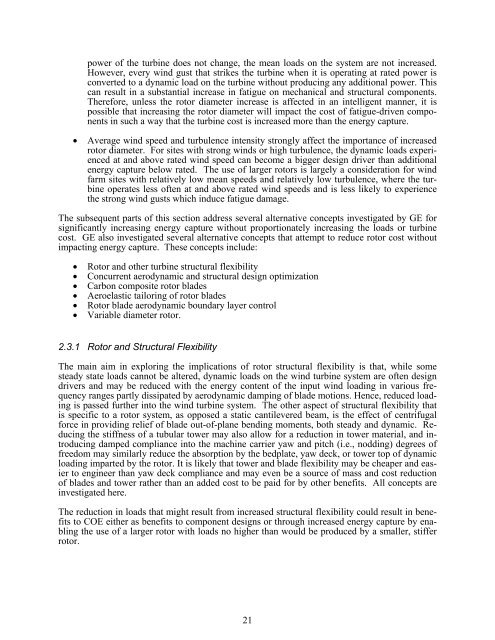Advanced Wind Turbine Program Next Generation Turbine ... - NREL
Advanced Wind Turbine Program Next Generation Turbine ... - NREL
Advanced Wind Turbine Program Next Generation Turbine ... - NREL
Create successful ePaper yourself
Turn your PDF publications into a flip-book with our unique Google optimized e-Paper software.
power of the turbine does not change, the mean loads on the system are not increased.<br />
However, every wind gust that strikes the turbine when it is operating at rated power is<br />
converted to a dynamic load on the turbine without producing any additional power. This<br />
can result in a substantial increase in fatigue on mechanical and structural components.<br />
Therefore, unless the rotor diameter increase is affected in an intelligent manner, it is<br />
possible that increasing the rotor diameter will impact the cost of fatigue-driven components<br />
in such a way that the turbine cost is increased more than the energy capture.<br />
• Average wind speed and turbulence intensity strongly affect the importance of increased<br />
rotor diameter. For sites with strong winds or high turbulence, the dynamic loads experienced<br />
at and above rated wind speed can become a bigger design driver than additional<br />
energy capture below rated. The use of larger rotors is largely a consideration for wind<br />
farm sites with relatively low mean speeds and relatively low turbulence, where the turbine<br />
operates less often at and above rated wind speeds and is less likely to experience<br />
the strong wind gusts which induce fatigue damage.<br />
The subsequent parts of this section address several alternative concepts investigated by GE for<br />
significantly increasing energy capture without proportionately increasing the loads or turbine<br />
cost. GE also investigated several alternative concepts that attempt to reduce rotor cost without<br />
impacting energy capture. These concepts include:<br />
• Rotor and other turbine structural flexibility<br />
• Concurrent aerodynamic and structural design optimization<br />
• Carbon composite rotor blades<br />
• Aeroelastic tailoring of rotor blades<br />
• Rotor blade aerodynamic boundary layer control<br />
• Variable diameter rotor.<br />
2.3.1 Rotor and Structural Flexibility<br />
The main aim in exploring the implications of rotor structural flexibility is that, while some<br />
steady state loads cannot be altered, dynamic loads on the wind turbine system are often design<br />
drivers and may be reduced with the energy content of the input wind loading in various frequency<br />
ranges partly dissipated by aerodynamic damping of blade motions. Hence, reduced loading<br />
is passed further into the wind turbine system. The other aspect of structural flexibility that<br />
is specific to a rotor system, as opposed a static cantilevered beam, is the effect of centrifugal<br />
force in providing relief of blade out-of-plane bending moments, both steady and dynamic. Reducing<br />
the stiffness of a tubular tower may also allow for a reduction in tower material, and introducing<br />
damped compliance into the machine carrier yaw and pitch (i.e., nodding) degrees of<br />
freedom may similarly reduce the absorption by the bedplate, yaw deck, or tower top of dynamic<br />
loading imparted by the rotor. It is likely that tower and blade flexibility may be cheaper and easier<br />
to engineer than yaw deck compliance and may even be a source of mass and cost reduction<br />
of blades and tower rather than an added cost to be paid for by other benefits. All concepts are<br />
investigated here.<br />
The reduction in loads that might result from increased structural flexibility could result in benefits<br />
to COE either as benefits to component designs or through increased energy capture by enabling<br />
the use of a larger rotor with loads no higher than would be produced by a smaller, stiffer<br />
rotor.<br />
21
















